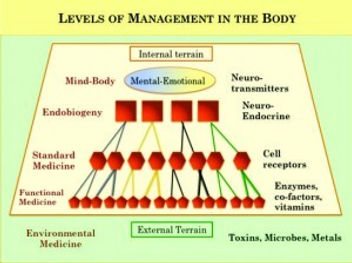ENDOBIOGENIC
MEDICINE
SOCIETY

Frequently Asked Questions



What is endobiogeny?
Endobiogeny is a theory of terrain that seeks to explain the method by which human life develops, maintains and adapts itself throughout its various phases, as managed by the endocrine system.
What do you mean by terrain?
Terrain is the structure and function of the body, including genetic heritage and expression. The structure of the body includes the brain, skeletal system, extracellular matrix, lymphatics, etc. The functional elements of the body include the endocrine, autonomic, and immune systems, neurotransmitters, etc.
What is the difference between endobiogeny and the terrain?
Endobiogeny is the terrain. The terrain is everything in man’s biologic existence. The endocrine system is the manager of this terrain. Therefore, endobiogeny is the study of how the endocrine system manages the terrain.
As the founder of endobiogeny explained: “Terrain is the ensemble of systems that, in the organism, permits man to constantly conserve intact the interior milieu against the external world in which it lives. Man is a functional physiologic entity, thus an ensemble of biologic mechanisms in permanent movement assures its maintenance in all circumstances. Therefore today we prefer to substitute, in place of the term terrain: 'endobiogeny'.”—Christian Duraffourd, Traité de phytothérapie clinique: Médicine et endobiogénie.
What does the terrain do?
The terrain is the manager of health. It assures the maintenance of the organism, the control of its defence function, and its return to homeostasis, thus ensuring the total restructuring of the organism.
How does the terrain manage health?
Through its management by the endocrine system, the terrain manages all phenomena: autonomic reflexes, voluntary responses, consciousness, unconsciousness, and all behaviours, be they intellectual, psychological or organic in nature.
Why do you focus on the endocrine system?
The endocrine system is the only system that is ubiquitous, can manage other systems and manage itself simultaneously. No other system in the body has these qualities. Thus, the endocrine system is the true manager of human physiology. The autonomic nervous system plays an important role in initiating and sustaining the endocrine system’s management of the terrain, but it is not the manager of the terrain per se.
Before any other system exists in the foetus, hormones manage its growth. During every phase of development, from birth to menopause to death, during pregnancy and every change of season, in response to every internal and external aggression, be it physiologic, physical or emotional, the endocrine system manages the nuclear, cellular, local, regional and global response.
What role do other systems play in managing the body?
All systems are important in the body, but they do not manage the terrain. Management of the terrain describes the ability to receive information about the internal and external environments, apply it relative to the current and anticipated internal needs of the organism in the context of its prior needs and achievements, and coordinate a response that satisfies those needs of the organism at the local, regional and global levels simultaneously. Management does not imply force, superiority, or exclusivity of influence, only the ability to determine and coordinate the timing, duration, quantity and quality of needs and fulfilment of those needs at all levels of the system.
The role of the immune and nervous systems, of the mind and emotions, etc, is important and is evaluated in every case. Regardless of the disease, its origin or the primary system affected, the endocrine system as the manager of the terrain plays a role in the genesis, installation and maintenance of every disease.
As the diagram below illustrates, as the highest level of management, small and subtle alterations in the endocrine system have an amplifier effect on all activity in the body, be it at the level of an organ, a tissue, a receptor, a cell, or the intracellular environment. This process is referred to as “hormesis.”

What about the role of environmental toxicity and pathogens?
Aggression on the organism is the genesis of disease. There is no doubt that an external aggressors, be it a heavy metal or a microorganism, can disrupt the body’s homeostatic state. However, it is the endocrine system’s management of the terrain that determines whether a person is susceptible to that external aggressor, and it is the organism’s response to that aggression (managed by the endocrine system) that determines the symptoms expressed by the individual.
Suppose 20 people at work are exposed to black mould. If only 3 out of 20 (15%) become ill, and only one severely, and if all three have varying symptoms, can we really conclude that the mould was the cause of disease? If you believe that it was, then 100% of those exposed should have become ill.
While we can conclude that the mould was the primary aggressor, we cannot say that it was the determinant of disease. After all, 85% of people exposed did not become ill. Each person had a different terrain, a different buffering capacity and a different management of the general adaptation syndrome by the endocrine system that determined if they became ill, how severely they became ill, which organs where most affected, and if or when they resolved their illness.
From the endobiogenic perspective, the decision to address a foreign aggressor will not be based solely on its presence in the body, neither in its absolute quantity, duration, nor its location. Instead it will be based on the degree to which it persists in aggressing the organism, disturbs the terrain, exhausts the buffering capacity of the organism, as well as on the likelihood (or not) that the endocrine system can restore the body ad integrum (to its prior state of integrity).
What about the role of emotions? Is there a place for mind-body medicine in endobiogeny?
As a humanistic system of medicine, endobiogeny acknowledges the role of emotions on health, based on the ability of emotions to alter the autonomic nervous system and perturb the endocrine system’s ability to manage adaptation and return to homeostasis. However, emotions are not the cause of the specific somatisation of an emotion. As with (external) environmental toxins, emotions are an internal aggressor (or benefactor) on the terrain. The terrain determines if, when, where and to what degree a physiologic effect occurs due to emotions.
Is endobiogeny different from Western medicine?
No. It’s a more refined application of modern medicine. Endobiogeny is based on the same principles of human physiology and scientific research as modern, biomedical (i.e. “Western”) medicine. A medical doctor originated the theory of endobiogeny, and many of its practitioners are medical doctors.
So endobiogeny is another form of Western medicine?
Endobiogeny is a humanistic approach to medicine, seeking, according to the Hippocratic oath, to “first do no harm”. Endobiogenic medicine transcends the information-based system of modern medicine to create a meanings-based system that reveals the origin, purpose and goal of balanced and imbalanced states in the body. This is done by integrating and relating the information obtained from a careful and thoughtful history, physical exam and serum blood evaluation (the Biology of Functions—c.f. below) into a meaningful understanding of the terrain.
What types of treatments are used in endobiogeny?
Any type of treatment can be used. In general, our approach is to use treatments that are best suited to the degree of imbalance in the body. For many cases, a rational use of medicinal plants works best. Dietary and lifestyle modification are also important. Homeopathy, vitamins and minerals can also be used, depending on the experience and training of the practitioner. The use of pharmaceutical drugs, radiotherapy and chemotherapy and surgery are reserved for more advanced cases where the patient’s buffering capacities have been exhausted and/or the severity of illness requires immediate and aggressive intervention.
There is a lot of evidence that modern pharmaceuticals work. Why not just use drugs to treat patients?
Modern pharmaceuticals offer power control of symptoms. For a decompensated patient, such products can play a stabilising or life-saving role. According to published reports, pharmaceutical products can induce tachyphylaxis (physiologic resistance), generate new diseases, and increase patient mortality and morbidity from primary action or drug-drug interaction.
Pharmaceutical products are not well suited to treat functional disorders such as subclinical hypothyroidism, fibromyalgia, or adrenal fatigue, where the disorder is related to abnormal relationships of normally occurring factors versus an absolute excess or lack of factors.
Medicinal plants, when used rationally and therapeutically, can address both the cause of the symptoms and relieve symptoms. The compounds in medicinal plants promote, alter, and facilitate normal physiologic processes rather than suppress or stimulate. At therapeutic doses they can preserve normal feed-back and feed-forward mechanisms that allow the body to regain its self-healing capabilities.
What is the Biology of Functions?
The Biology of Functions is a biological modelling program that quantifies the functional abilities of the body before and after the effects of adaptation to stressors.
How does the Biology of Functions work?
Seventeen blood values are evaluated through a series of direct and indirect ratios to create an increasingly complex and sophisticated evaluation of relative function of the body at the metabolic, cellular, tissue, organ and systemic levels, in its basal and adaptive states, as well as in its structure and function.
What advantage does the Biology of Functions provide over standard blood tests?
Standard blood tests are binary: they only answer the question, “Is the value normal or abnormal?” If the values are normal, they usually do not indicate if that normal value is sufficiently normal relative to other values, nor can they determine why an abnormal value is deranged.
The Biology of Functions helps explain the origin and purpose of physiologic states, contextualising these findings in a clinically relevant way. Ultimately, it facilitates the development of a rational treatment plan unique to each patient.
How can so much information be derived from a few blood tests?
There are three basic observations that allow us to derive so much information from common blood tests: 1) the endocrine system is the manager of the body; 2) because endocrine management of metabolism influences the levels of certain circulating blood elements, those circulating elements reflect the relative functionality of the endocrine system; 3) because the true functionality of the body is based on the relative activity of one factor to another, indexing blood values as ratios provides an assessment of endocrine management of the terrain.
Is relative function and ratios a new concept in medicine?
No. The principles have been observed for over 70 years and published in various peer-reviewed journals of physiology and clinical research. What is new is the degree of sophistication that the Biology of Functions offers.
Numerous simple ratios are used everyday in modern medicine to evaluate relative function, for example: BUN:creatinine ratio, haematocrit (RBC/whole blood) and total cholesterol:HDL ratio. In addition, there is increasing recognition of the need to evaluate ratios of serum levels of hormones in the blood to understand functional illnesses, such as the LH:FSH ratio, oestradiol:dihydrotestosterone ratio and the glucose:insulin ratio.